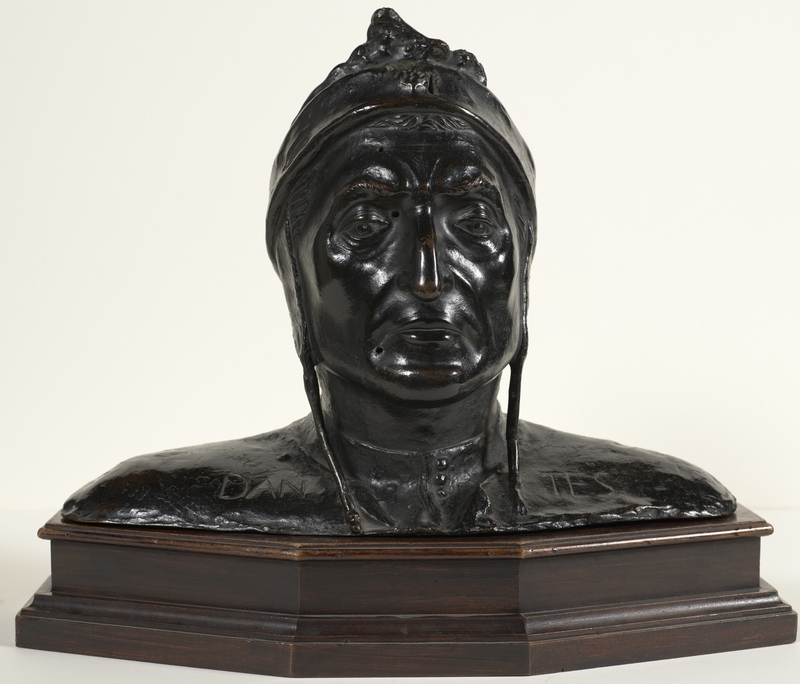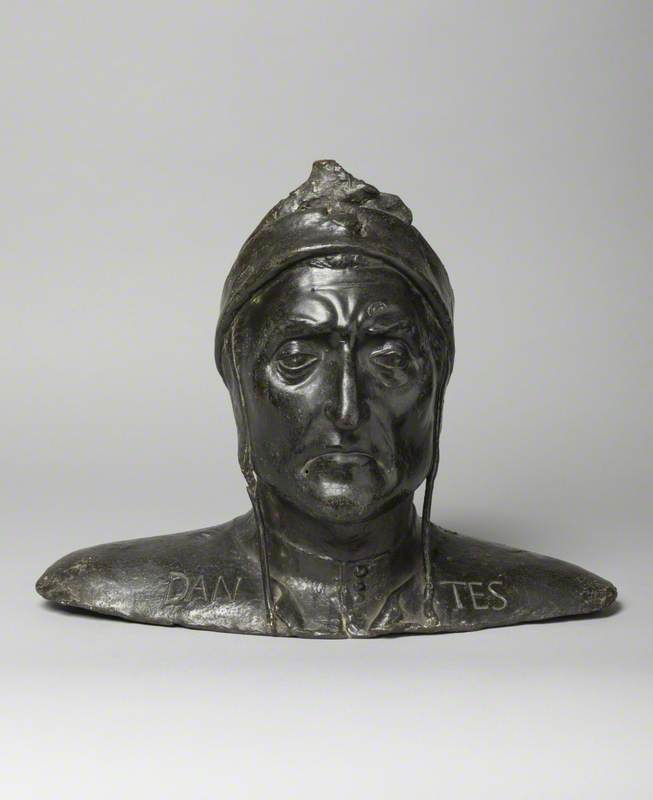
Dante Alighieri (1265–1321) 1886
Salvatore Errico (1848–1934)
John Rylands Research Institute and Library
A decorative sculptor in Naples who also established an antiques business there and was succeeded in both areas of activity by his son Umberto (1884–1945). The latter’s son Gustavo (1910–1984) was solely an antiques dealer, with succession to his son Umberto (1948–2017): today the firm trades as ‘Antichitá Errico’ under his son Gustavo (b.1979). While original pieces by Salvatore occasionally feature at sale, he mainly seems to have been one of many Neapolitan bronze-founders and other craftsmen who appeared after the Museo Nazionale there became a public body in 1860 and began to issue permits to reproduce Classical antiquities in its collection. According to Carol C. Mattusch, others doing so by the early 1900s were Gennaro Chiurazzi, the foundry of Giorgio Sommer (1834–1914, as an adjunct to his photography business), A.
An advertisement for Errico’s foundry at 75 Strada Nuova, Capodimonte, in the Annuario d'Italia, Calendario Generale del Regno of 1893 shows he successfully exhibited cast reproductions and possibly original work in Turin (1884), Paris (1885, 1886 and 1889), Rome (1886), Liverpool (1887) and London (1887–1889), winning various awards including a Diploma D’Honore at the Italian exhibition in London in 1888.
At the Rome exhibition of Oggetti Artistici di Metal in 1886 he and Sabatino de Angelis won bronze medals for the quality of their work in bronze-cast reproductions and examples by both were among 24 works bought by the Italian Ministry of Agriculture, Industry and Commerce for later distribution among museums and art schools. Alfonso Panzetta’s dictionary of Italian sculptors (2003 edn) also mentions Errico as author of small animal bronzes and exhibitor of two works at the 1888 National Exhibition in Bologna: Piccolo marinaio (‘small seaman’, a bronze head) and Dopo il pasto (‘after the meal’, bronze). He also notes four works that he exhibited in Florence in 1889: Vittorio [Vittoria?] (135 lire); Psiche (35 lire, which had previously received an award when shown in Paris); Dante (35 lire); Battente pompeiano (‘door-leaf from Pompeii’, 17 lire, likewise awarded a prize in Paris) and another piece of the same title.
In Rome in 1886, Errico’s Dante was shown amid group no. 16 of the modern casts (catalogue p.252) with his statues of two dancing fauns; his bronze reproduction busts of Cicero and the young Brutus, copied from originals in the Museo Nazionale, Naples, were in group no. 47 (p.261). The Dante was his reproduction of an apparently 16th-century anonymous bronze that was in the Farnese collection by 1644 and is now in the Museo di Capodimonte, Naples (no. 10516), but was probably in the Museo Nazionale when copied by him and others. It is now thought to be from a lost portrait of Dante by the Florentine painter Taddeo Gaddi that was formerly in Santa Croce, Florence. A wide range of bronze and other copies based on it are also still in market circulation.
The John Rylands Library, University of Manchester, has a finely mounted version of Errico’s Dante, bequeathed as part of the library of the University’s bibliophile benefactor Professor Richard Copley Christie in 1901. Another, unmounted, is in the Williamson Art Gallery, Birkenhead. There is also one by de Angelis at Sudbury Hall, Derbyshire, that belonged to the Dante scholar, the Hon. William Borlase-Warren-Venables-Vernon (whose library is also there in what was formerly the family house, now National Trust). The Bodleian Library has one by the Sommer foundry (acc. no. LP 804). Another, made in 1883, and one in wax, are in the V&A but their makers are not recorded. The Newport Museum and Art Gallery also has one in ‘metal’ but maker identity and other details are unknown.
Summarised from Art UK's Art Detective discussion 'Can we find out more about the sculptor Salvatore Errico?'
Text source: Art Detective


